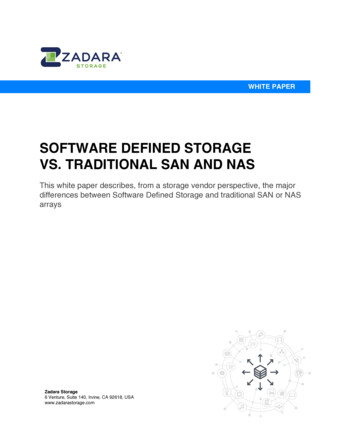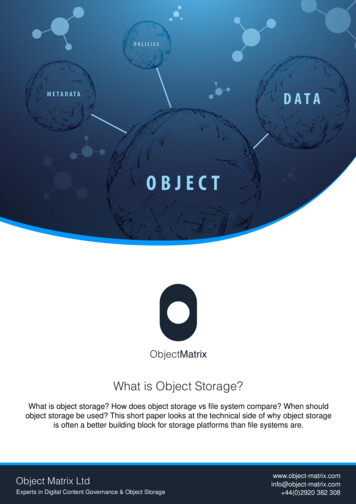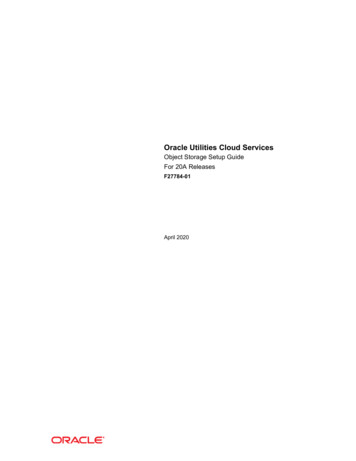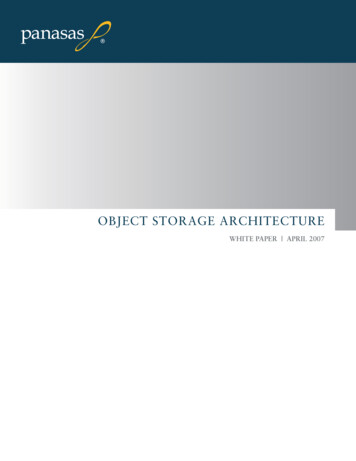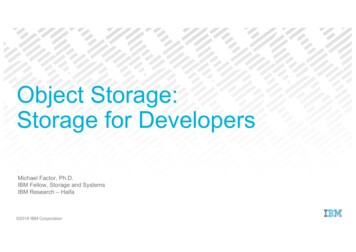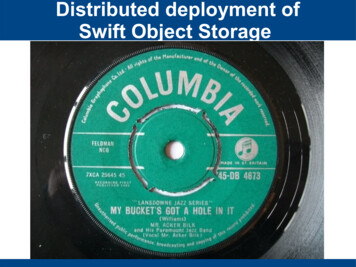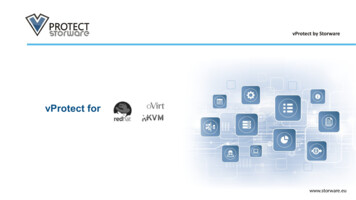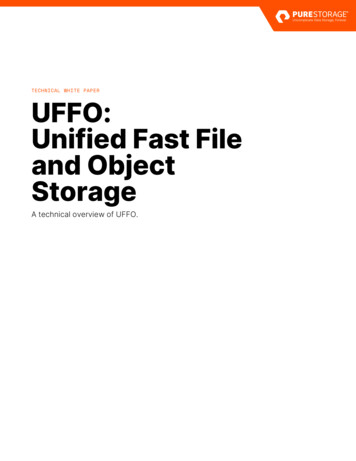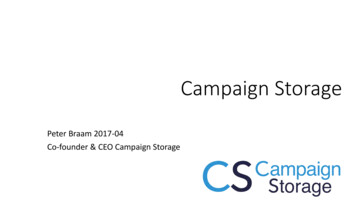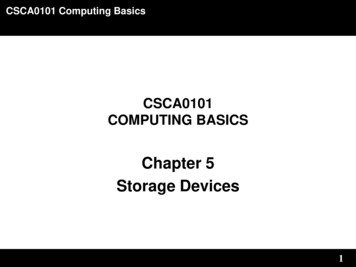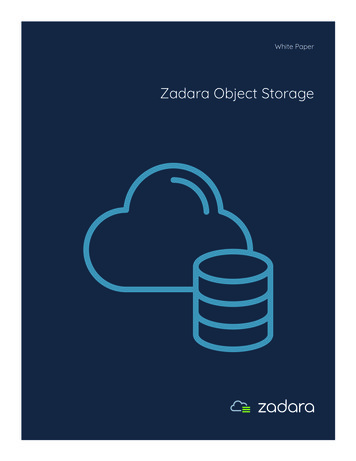
Transcription
White PaperZadara Object Storage
White PaperExecutive SummaryCloud providers using Zadara’s technology can now offer S3/Swift compatibleobject storage. Object Storage is simple, easy to use, and well protectedsolution for storing multimedia data, sensors sampling big data, or archivingdata of any sort. Object Storage runs side by side with virtual private storagearrays on Zadara’s clouds, utilizing the same infrastructure, and providinghigher value to our customers.2
White PaperWhat is Object Storage?Object Storage is an alternative way to store, organize and access unitsof data. It provides a reasonable balance between performance andfunctionality versus simplicity and scalability. Object Storage enables aminimal set of features: store, retrieve, copy, and delete objects. These basicoperations are done via REST APIs that allow programmers to work with theobjects. The HTTP interface to Object Storage systems allows fast and easyaccess to the data for users from anywhere in the world.The Differences Between Object Block, and File StorageObject Storage is much more scalable than file storage because it is vastlysimpler. Objects are not organized in hierarchical folders, but in a flatorganization of containers or buckets. Each object is assigned a uniqueID or key. Their keys, regardless of where the objects are stored, retrieveobjects. Access is via APIs at the application level, rather than via OS at thefile system level. As a result, Object Storage requires less metadata, and lessmanagement overhead than file systems. This means Object Storage can bescaled out with almost no limits. Object Storage is easier to use than blockstorage and overcomes the limitation of fixed size LUNs. It also removes filesystem limitations such as the folder size or path name length. Unlike block orfile, Object Storage does not use RAID for data protection. It simply keeps anumber of copies of each object.What is Private Object Storage?Private Object Storage is an Object Storage solution built on dedicatedcompute resources either in a private or public cloud. As such, it guaranteesbetter isolation and security to ensure no performance impact by otherusers of the object storage. Object Storage in a private cloud enables all ofthe benefits of the public Object Storage. However, it eliminates the latenciesassociated with the Internet and the public cloud, and therefore, providesmuch better performance.3
White PaperObject Storage Use CasesThe common use of object storage is for big amounts of relatively static data,like: Multimedia - music, images, and videoBackup files, database dumps, and logsBig Data - Large data sets. Pharmaceutical or financial data, sensordata, scientific research data samplesArchive files in place of local tape drivesWeb contentFigure 1: Typical Data ProfileObject Storage CharacteristicsObject Storage is Zadara’s object storage service. It is provided on Zadaraclouds, side by side with the virtual private storage array that provides blockand file storage services. These are the key properties of Object Storage: Flat namespace (key/value store)Unlimited scalability (scaling out) in both capacity and total objects simply keep adding drivesUser-defined object’s metadata2- or 3-way distributed data protection“Eventually consistent” copiesSupports both S3 and Swift REST APIComprehensive usage reporting and meteringMulti-tenancy at both the object storage and account levels4
White PaperProvisioningObject Storage is ordered andprovisioned just like the virtualprivate storage array, by request atthe Zadara Provisioning portal. Theadministrator selects the numberand type of drives to be assignedto the newly created Virtual privatestorage array, and the systemautomatically assigns the needednumber of Virtual Controllers (VC’s).The administrator receives accessto the object storage that containsa default account. At that point, theadministrator can create accounts,assign account administrators, andcan begin storing objects.Figure 2: Object Storage Provisioning PortalObject Storage Usage ModelObject Storage may contain any number of accounts that are assigned todifferent organizations. Users of each account can store objects, and organizethem in containers, as illustrated to the right. Object Storage is the entireobject storage. It may contain anynumber of accounts as defined bythe administrator.Accounts are assigned toan organizational unit or adepartment, and contain a list ofuser-defined containers.Containers are uniquely namedbuckets with flat structures thatcontain objects.Objects are a piece of data of anysize. A key that is assigned to ituniquely identifies them.Figure 3: Object Storage Structure5
White PaperAuthentication and PermissionsThere are three types of users assigned to Object Storage: Administrator is responsible for the administration of the object storage.The user (registered in Zadara Provisioning Portal) that orders the objectstorage becomes the Administrator. By default, the object storage iscreated with one account (Administrator account) and the Administratoris a member of this account. Administrators can add other users with thesame role. Administrator is a super-user with privileges to create accountsand users of any role. Users with Administrator role can define policies,add/remove drives and assign drives to policies. Users with Administratorrole can perform containers and objects operations across accounts. TheAdministrator is also responsible for the Object Storage settings (like IPaddresses, SSL certification, etc.), and has access to the Object Storagemetering and usage information.Account administrator can create an account and can manage theirown account. They can perform any user management and containers/objectsMember can do object storage operations according to the permissiongiven by the account administrator, within the limits of that account.These operations include create/delete/list containers and create/delete/list objects. User authentication is done against an internal Object Storageusers database.Data Protection and High AvailabilityObject Storage data protection and reliability is achieved by replicatingobjects across multiple storage nodes and disk drives. The user can configurethe number of replicas to suit their needs. The minimal Zadara object storageconfiguration utilizes three storage nodes. Zadara object storage with theredundancy of three copies can survive any double failure of drives, virtualcontrollers, or physical storage nodes. Administrators can define a numberof protection policies, determine the drive types, and redundancy levels ofeach policy. Containers are created within a given policy. Default policy isautomatically generated at the Object Storage creation time.6
White PaperArchitectureObject Storage is built on two main building blocks: Proxy Layer (Node) andStorage Layer (Node). The proxy node is the interface to the users or theapplication using the data objects. The Proxy node gets the API command,authenticates the requester, decides what storage node should handle thecoming request, and passes it over. Once the appropriate storage nodehandles the request, the proxy returns the answer to the caller. The storagenode is responsible for storing the objects on the drives, and updating themetadata in the databases. The load balancer controls the traffic fromall clients to all Proxy Nodes. Object Storage comes with an internal loadbalancer, but users can configure the external load balancer outside of theZadara environment, to get even better performance.Figure 4:Logical ObjectStorage ArchitectureObject Storage and Storage Arrays, Side-by-SideZadara Cloud side by side with Zadara virtual private storage arrays. Theobject storage infrastructure is a collection of Virtual Controllers (VC) anddrives across the cloud storage nodes. VC’s are dedicated Virtual Machines(VM) running the Proxy and Storage Nodes as described above. Just likevirtual private storage arrays, Object Storage has dedicated drives assignedto it to store the data. Object Storage automatically distributes the load acrossthe storage nodes in a way thatguarantees the system survival,even in case of Storage Nodefailures. Drives assigned to objectstorage are organized in policiesaccording to the redundancylevel required (2-way or 3-way).When drives are added to theconfiguration, Object Storageautomatically redistributes theFigure 5: Logical Object Storage Architecturedata across all drives.7
White PaperObject Storage uses large SATA drives (per customer order) to store objectcontents, and fast SSD drives (automatically assigned) to store the usersand container databases. By default, each Zadara object storage VirtualController contains one Proxy Node and one Storage Node. Users with heavytraffic can add additional Proxy Nodes in additional VC’s. These can beordered from the provisioning portal.OperationsObject Storage fully supports bothAWS S3 API and OpenStack SwiftAPI. For API details refer to the APIdocumentation. Both are RESTAPI over HTTPS. The four basicoperations are: 1) PUT that writes anobject, 2) GET that reads an object, 3) DELETE; and 4) COPY object. The flowof these operations is described in the diagrams below:PUT Operation1.2.3.4.5.PUT (Object) request comes from client.Load-balancer selects a ProxyNode and routes request to it.Proxy determines the StorageNodes to handle the request.Proxy sends the object to 2 or3 replicas.Proxy queues container DBupdates, and completes thePUT operation.GET Operation1.2.3.4.5.GET (Object) request comes from client.Load-balancer selects a Proxy Node and routes request to it.Proxy determines the StorageNode to handle the request.Storage Node reads the object.If failed, the proxy will retry toread from another replica.Proxy returns the object to thecaller.8
White PaperPerformanceObject Storage does not guarantee performance, as it depends on theconfiguration and the workload.As a quick reference, here are some performance measurements taken withZadara object storage built over 4 VC’s with 20 x 6TB drives, using a 2-wayprotection policy.Object SizeWorkloadOps/secBandwidth MB/s4KB100% PUT50024KB100% GET150061MB100% PUT1501501MB100% GET50050010MB100% PUT2017010MB100% GET65650Billing and ChargebackObject Storage provides usage and billing reports both at the storage and theaccount level. The reports contain details regarding the capacity consumedand upload/download traffic. Usage reports can be exported as CSV files forfurther processing in external billing tools.ConclusionObject Storage complements Zadara offerings for public and private clouds.In addition to block and file storage services, Zadara now offers ObjectStorage to fit the needs of any storage workload. Customers storing staticdata can enjoy Zadara object storage and its infinite scalability. Cloudproviders using Zadara’s technology can now offer S3/Swift compatibleobject services. Object Storage is simple, easy to use, and well protectedsolution for storing multimedia data, sensors sampling big data, or archivingdata of any sort. Object Storage runs side by side with virtual private StorageArrays on Zadara’s clouds, utilizing the same infrastructure, and providinghigher value to our customers.9
White PaperTransform your business with zero-risk enterprise storage.Zadara transforms storage-related costs from a variable mix of equipmentand management expenses to a predictable, on-demand, pay-per-use, elasticservice that greatly simplifies planning, streamlines budgeting, and improvesreturn on investment (ROI). Find out how zero-risk enterprise storage can helptransform your business. Call or email today. 1 949 251 0360sales@zadara.comwww.zadara.com 2018 Zadara Storage, Inc. All rights reserved. Zadara is a registered trademark of Zadara Storage, Inc. Rev. 111618
object storage. Object Storage is simple, easy to use, and well protected solution for storing multimedia data, sensors sampling big data, or archiving data of any sort. Object Storage runs side by side with virtual private storage arrays on Zadara's clouds, utilizing the same infrastructure, and providing higher value to our customers.
